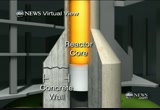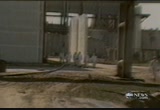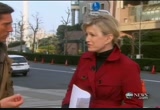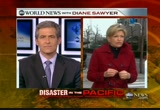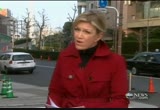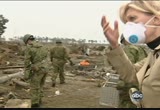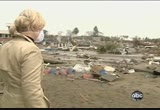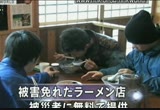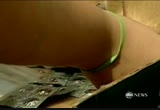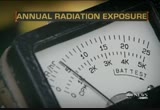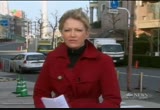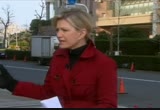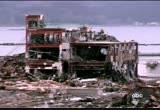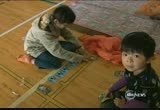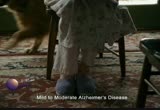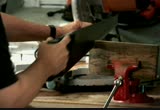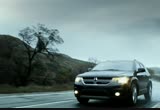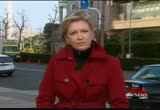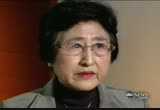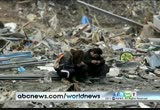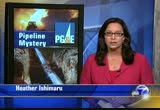tv ABC World News With Diane Sawyer ABC March 15, 2011 5:30pm-6:00pm PDT
5:30 pm
>> i've done that. >> yes, you have. that's going to d tonight from japan, this is "world news," reporting on the disaster in the pacific. now, there are four. four troubled nuclear reactors at one site. what happens if they all melt? and who are the 50 brave workers who agreed to stay inside and try to save everyone else? we go out with rescue crews, calling out for signs of life in the rubble. "make a noise," they say. "is anybody there?" hello? is anybody there? is anybody there? and survivors did emerge today. and we tell you what is the real danger for the united states. what about that run on potassium iodide pills? and, on "world news," lessons for all of us, from survivors of that hiroshima radiation 60 years ago.
5:31 pm
good evening to everyone in the united states. here in japan, as we said, there are 50 workers inside a nuclear power plant, and they are battling the complete unknown at this moment. trying to prevent a nuclear power meltdown. and in this breaking news, we have received word that there is another fire, a new fire under way at one of those reactor sites. let me show you a headline in the newspaper here. this is the japanese symbol for stop. these are the symbols that say, it is not stopping, it is deteriorating. and at the same time, the sea of humanity is in the rubble all across this country, up north, where the devastation occurred. we see people standing there, a half million of them, homeless. not to mention, all of those waiting in the lines for the
5:32 pm
scarce supplies at the grocery stores, now running out. but i want to turn to david muir, he drove into tokyo last night, through the night, as i did, and we were saying, david, the more the government goes on the air to say stay calm, we're sorry, but stay calm, the less calming it is. >> reporter: and that's exactly what the prime minister said last night, diane. stay calm, but then he warned of possible more radiation to come. you spoke of the hundreds of thousands of evacuees now headed away from the nuclear power reactors. that have caused so much trouble. now, the question about the band of workers who stayed behind. at what risk? the line of cars stretched for miles. a race to get out of the danger zone. 200,000 people and counting trying to get away from those battered nuclear reactors. evacuation shelters had trouble keeping up. and many people in the shadow of those reactors are now terrified and angry. this man said nuclear power is the most frightening thing, more than the tsunami. the government, nobody tells us, the citizens, what is really happening.
5:33 pm
their anger comes after the prime minister of japan told the nation the leaked radiation level is now rather high and there is high chance for further leakage of radiation from now on. over the past couple of days, one reactor exploded after another. then, yesterday, the first fire broke out and an unprecedented third reactor exploded, both sending radiation into the air. officials worry this blast was the worst, cracking part of the critical container that surrounds the fiery hot nuclear core. >> the radiation levels are getting so high that the workers can't stay there. >> reporter: in fact, for the first time, 750 workers at the fukushima plant were told to leave. to seek safe shelter. only about 50 now remain. they are the last line of defense, willing to stay and continue what so far has been a difficult mission. using fire pumps to flood ocean water into those red hot cores so they don't melt down completely. nuclear experts tell us they are likely wearing full body suits
5:34 pm
with air packs, rotating in and out, resting in some sort of armored control room or safe room. bravery beyond measure. in fact, the medical community tells us if the workers absorb radiation levels reaching 1,000 millisieverts, the equivalent of 25,000 x-rays at once, the symptoms are immediate. from vomiting to a steep decline in white blood cells, wiping out their immune system. we've seen it before, the workers that stayed behind at chernobyl. 28 firemen and emergency workers dying within just three months time. they were the ones who stayed behind to try to save the plant. >> they knew that by trying to contain the fire at chernobyl, they would be exposed to lethal radiation. they did it anyway. you have to think that at least some of the workers at this japanese facility understand the risks and seem to be willing to pay that price. >> reporter: and as we left the evacuation zone surrounding fukushima -- you can see, you
5:35 pm
know, we're sitting in traffic -- the crush of evacuees heading for safety as those brave workers stay behind. today, the iaea had reported that the radiation levels here in japan had decreased and some people were asking if this country had, in fact, dodged a bullet. but tonight, that new fire under way. it points out just how hour by hour this has been unfolding. >> volatile in every sense of the word. and for those of us who heard first about nuclear power plants, probably from the phrase china syndrome, we wondered if it's still a reality, a tunneling through the earth. so, we asked our martha raddatz to tell us more tonight. >> reporter: how bad could it get? the big fear is nuclear meltdown. meaning the reactor core gets so hot, it turns into a radioactive molten mass, breaks through the containment vessel, spewing radioactivity through the air, ground and water. in the hollywood "china syndrome" version, they claim
5:36 pm
the mass could melt through a steel floor, through the earth, to china. no one thinks that could happen. but the reality for japanese reactors? >> this is way past three mile island and we are heading into chernobyl territory. >> reporter: the difference? three mile island was only a partial meltdown that stayed inside a containment vessel. the result? no injuries, no serious radiation leak. chernobyl, total meltdown. no containment vessel. radiation spewing for thousands of miles, leaving death and increased cancer rates in its trail. in japan, there are six-foot thick concrete and steel containment vessels, with that one now believed to be cracked and leaking. which means that if there is a nuclear meltdown, more radiation escapes and it could happen in more than one reactor. what could be done to stop it if efforts to cool the reactors with sea water finally fail? >> try to surround that molten
5:37 pm
mass with sand and concrete. entomb it. >> reporter: a massive operation the japanese are not yet ready to try. martha raddatz, abc news, washington. >> thanks, martha. i want to turn now to our medical editor dr. richard besser with questions about radiation and the body, rich. we heard david muir tell us that those who are right around the worst of the site could see immediately the effects of radiation poisoning. what do you do if that happens? >> reporter: well, diane, what you're going to see, radiation effects your entire body. what you're going to see early on is radiation effecting the parts of the body where cells divide very quickly. that's your gastrointestinal track. you're going to see nausea, vomiting, diarrhea and fever. the same kinds of things people have when they're going through radiation treatment for cancer. that will let you know you've had a big dose of radiation. >> and again, we're talking about acute radiation poisoning, with those symptoms. i want to move out to the wider circumference of people who have been told to stay inside or try
5:38 pm
to evacuate. what are the effects on small children and what about pregnant women and what about breast milk? >> reporter: well, you know, one of the big effects that you want to try and prevent is the development of thyroid cancer. and the reason that's a risk, and it's a risk in particular to young children and pregnant women, is that the thyroid gland in your neck takes in iodine, and iodine is one of those radioactive elements released very early from a reactor. so, that comes into your body, it goes into your thyroid gland where you make a hormone. you can block that by giving people potassium iodide. those with the pills that are being distributed. you can protect them from thyroid cancer. >> right. i want to show everybody this pill, because we've all been issued them here, these tiny pills. you have to be careful about taking them for too long a period? especially children? >> reporter: well, you don't want to take them unless it is necessary. if you are being exposed to ongoing radioactive iodine,
5:39 pm
taking those pills far exceeds any risk. however, they can be a risk to very young babies. they can cause mental retardation. you don't want to use them without guidance. you want to listen to the recommendations and follow them very closely. >> and we want to thank you, rich besser, and tell everyone that you're going to post more information about radiation and the body online. some numbers now in tonight. we now have 3,500 confirmed dead here in the disaster area in japan. and at least 7,400 reported still missing. that undoubtedly will rise. and we were out earlier today with some of the rescue teams who are going house to house, looking for a hopeful sound. can't imagine how they're going to clean this up. look at this. shovels, probes and their voices. that's all they have. no little microphones. no sniffing dogs. over and over again, we hear
5:40 pm
them shout. "anyone there? are you there? are you there? make a sound, any sound. we'll hear you." there is only silence answering them. and the irony of the birds chirping in the trees. do you still hope to find survivors? yes? you do? so, any of these houses could still have somebody in it? >> yes, indeed. >> reporter: the refrigerator door has opened. out pours the noodles. daily life, frozen in place. look at this one. how would you know? hello?
5:41 pm
this is unbelievable. they're going room by room? all the shoes that you wear, slippers that we put on because you don't track dirt inside a japanese household. they still have the dishes on the shelves. so it really came up just below those cups. can you see? everything else perfectly stacked. oh. a dog. so, you get a sense of the distance. this is the ocean, the other side of the trees. so it had to go over those trees, through this plane, over the other and straight on up. but there's no cliff. there's nothing to stop it. it's just -- it's got a flat, direct route. in another part of the devastation, american workers from los angeles and fairfax, virginia, scour the town. and they do have rescue dogs, listening equipment, state of
5:42 pm
the art. so far, no survivors there. up in a port city north of us, unexpected joy. this man, rescued after five days buried in rubble. reunions in person. and by phone. and not far away, one of those signs of community we've come to expect everywhere in japan. the noodle shop escaped the water, but is offering meals at no charge. the cook says his home was washed away, but he comes to work, he says, because he wants to do something for those that have even less. and we have seen so much generosity here. when we come back, what is the real danger that radiation from japan could travel all the way to the united states? and how does that compare to the radiation we receive already in our daily lives? ♪
5:43 pm
i have clients say it's really hard to save for the future and they've come to a point where it's overwhelming. oh gee, i'm scared to tell you i've got this amount of credit card debt or i've got a 15-year-old and we never got around to saving for their college. that's when i go to work. we talk, we start planning. we can fix this. when clients walk out of my office they feel confident about their retirement. [ male announcer ] visit ameriprise.com and put a confident retirement more within reach. ♪ [ male announcer ] what are you gonna miss when you have anallergy attack? benadryl® is more effective than claritin® at relieving your worst symptoms and works when you need it most. benadryl®. .you can't pause life. [music playing] confidence available in color.
5:44 pm
depend® colors for women. looks and fits like underwear. protects like nothing else. depend®. good morning. great day. i'm friend, secret-keeper and playmate. do you think i'd let osteoporosis slow me down? so i asked my doctor about reclast because i heard it's the only once-a-year iv osteoporosis treatment. he told me all about it and i said that's the one for nana. he said reclast can help restrengthen my bones to help make them resistant to fracture for twelve months. and reclast is approved to help protect from fracture in many places: hip, spine, even other bones. [ male announcer ] you should not take reclast if you're on zometa, have low blood calcium, or kidney problems. or if you're pregnant, plan to become pregnant or are nursing. take calcium and vitamin d daily. tell your doctor if you develop severe muscle, bone or joint pain, if you have dental problems, or if you develop new or unusual pain in your hip, groin, or thigh. the most common side effects include flu like symptoms, fever, muscle or joint pain headache, nausea, vomiting and diarrhea. share the world with the ones you love!
5:45 pm
and ask your doctor about reclast. once-a-year reclast. year-long protection for on-the-go women. as we said, we wanted an answer. what are the real odds that radiation from japan could travel all the way to the united states? and how much would it really be? so, right now, dan harris has our reality check. >> reporter: across america tonight, the radiation fears are palpable. there's a run on iodide pills, geiger counters and emergency kilts on amazon.com. and everywhere from hawaii -- >> i don't trust what they're saying. >> reporter: to seattle to missouri. but how worried should we really be? radiation is all around us and even inside of us, all the time and it's perfectly natural and safe. to illustrate the point, we got ahold of this geiger counter. and as you can see, even right here in the middle of central park, new york city, there is always a background level of radiation. check this out.
5:46 pm
we're going to put this on ban th bananas, which contain potassium, and the counter goes up just a little bit. and for the most dramatic reading, here is what happens when we go up to this monument. it's made out of granite. granite is radioactive but perfectly safe. and as you can see, the meter is pretty much pinning. in fact, you're exposed to it every time you fly because you're closer to the radiation of outer space. every year, just walking around the planet, each of us is exposed to about 3.5 millisieverts, that's the term they use, of radiation. that's about 67 chest x-rays or the same of 134 cross-country plane trips. in order to get radiation sickness, you need to be exposed to 1,000 millisieverts at once. and for most people, a fatal dose is about five times that. to put this all in perspective, the radiation levels at the scene of the fire of the nuclear power plant in japan reached
5:47 pm
about 400 millisieverts. meaning you would have had to sit there for about 2 1/2 hours to get sick. but what about the worst case scenario? what if there's a full meltdown? will that reach us here in america? >> even if we had a chernobyl-type accident, the impact on the united states would be minimal. >> reporter: which is why, despite those scary pictures out of japan, the experts are telling us tonight that there is no threat to us here. dan harris, abc news, new york. and when we return, we are going to take you to an inaccessible part of japan and show you how a human chain did so much to help save lives. i've had asthma for 11 years... ...but my symptoms kept coming back... ...kept coming back. then i found out advair helps prevent symptoms from happening in the first place. advair is for asthma that's not well controlled on a long-term asthma medicine, such as an inhaled corticosteroid. advair will not replace a rescue inhaler
5:48 pm
for sudden symptoms. advair contains salmeterol which increases the risk of death from asthma problems and may increase the risk of hospitalization in children and adolescents. advair is not for people whose asthma is well controlled with a long-term asthma control medicine like an inhaled corticosteroid. once your asthma is well controlled your doctor will decide if you can stop advair without loss of control and prescribe a different asthma control medicine, such as an inhaled corticosteroid. do not take advair more than prescribed. see your doctor if your asthma does not improve or gets worse. is advair right for you? ask your doctor. get your first prescription free. advair helps prevent symptoms.
5:49 pm
goals for the future... what if they were .stolen from you? by alzheimer's. this cruel disease is the .sixth leading cause of death, and affects ! more than 5 million americans. the alzheimer's association istaking action, and has been a part of eery major advancement. but we won't rest .until we have a cure. you have dreams... help the alzheimer's association protect them. act now, go to alz.org. you can turn ordinary chicken into luscious, delicious, and scrumptious. with recipes from campbellskitchen.com, and campbell's cream of chicken soup. campbell's.® it's amazing what soup can do.™ oh, bayer aspirin?
5:50 pm
i'm not having a heart attack. it's my back. it works great for pain. [ male announcer ] nothing's proven to relieve pain better than extra strength bayer aspirin. it rushes relief to the site of pain. feel better? yeah. thanks for the tip. and again, we're reporting to you from central tokyo tonight. we'd show you the whole city but we're not allowed to be up high because of the aftershocks and no one wants to have us up on balconies or on the roof. but i want to bring in clarissa ward, who covers asia for abc news, beuse you went to some of the most inaccessible regions and you saw some t things that both inspired and haunted you, i know. >> reporter: that's right, diane. just scene after scene of death and destruction. it's almost hard to convey with words the scope of this devastation. pushing up japan's coast, a series of surreal landscapes. boats swept miles inland, ships tipped on their side.
5:51 pm
now, the ocean is actually just under a mile in that direction, but looking behind me, you would never imagine that because huge swaths of this town are still completely submerged under water and, of course, it's impossible to know just how many people died here until that water recedes. the japanese army is just starting to come in to help, but for most aid workers, it is a logistical nightmare, hampered by roads blocked by debris. the japanese red cross tells us radiation concerns have not impacted their operations, but every radiation scare means more evacuees, more people without homes. there are simply so many people who need so much help. residents improvising tools for survival. a man cutting into this drum so it could be used to boil water, and a bucket brigade. villagers in a line working together to have some clean water. at this makeshift shelter, we meet 81-year-old kaneo karino.
5:52 pm
"i couldn't see my wife anywhere," he tells me. "and then she came to the surface, so i grabbed her hair and pulled her onto the log." 26 hours later, they were rescued by a helicopter. "as we flew away, i looked down and i saw that the entire village was gone," he says. "i have no idea if anyone else is alive." it's one of many sad stories. still, people find solace in sharing their experiences. and come up with ways to pass the time. savoring small pleasures, lucky to be alive. and of course one of the other challenges facing the aid workers is just the enormous amount of aftershocks. literally, sometimes every five or ten minutes and every time there's an aftershock, there is always the fear there will be an tsunami. >> and, we should say again, it is freezing here. and freezing at night. so, for people to survive at all
5:53 pm
is so tough, without electricity. and those roads were cracked in places as you tried to travel. >> reporter: roads cracked, trees blocking the way, landslides. incredibly difficult terrain to navigate, diane. >> all right, clarissa, thank you. and, a survivor's club, of sorts, telling you the lessons they learned, coming up next. it's from a terrible war between japan and the united states. it's from a terrible war between japan and the united states. it's from a terrible war between medication continuously -- s for twenty-four hours. she uses one exelon patch daily for the treatment of mild to moderate alzheimer's symptoms. [ female announcer ] it cannot change the course of the disease. hospitalization and rarely death have been reported in patients who wore more than one patch at a time. the most common side effects of exelon patch are nausea, vomiting, and diarrhea. the likelihood and severity of these side effects may increase as the dose increases. patients may experience loss of appetite or weight. patients who weigh less than 110 pounds may experience more side effects. people at risk for stomach ulcers
5:54 pm
who take certain other medicines should talk to their doctor because serious stomach problems such as bleeding may worsen. people with certain heart conditions may experience slow heart rate. [ woman ] whenever i needed her, she was there for me. now i'm here for her. [ female announcer ] ask the doctor about your loved one trying the exelon patch. visit exelonpatch.com to learn more. so i've got to take care of my heart. for me cheerios is a good place to start. [ male announcer ] to keep doing what you love, take care of your heart with cheerios. the whole grain oats can help lower cholesterol. love your heart so you can do what you love.
5:55 pm
to finish what you started today. for the aches and sleeplessness in between, there's motrin pm. no other medicine, not even advil pm, is more effective for ain and sleeplessness. motrin pm. inside the 2011 dodge journey is an 8.4-inch touch screen that lets you control the stereo volume, radio tuning, climate controls, turn-by-turn navigation, and bluetooth activation -- technology inside technology controlling more technology. welcome to the future. now lease the new 2011 dodge journey mainstreet for $299 a month for well-qualified lessees.
5:56 pm
as americans remember, so many lives were lost as americans battled the japanese in world war ii. and two atomic bombs were released in an effort to prevent more american lives being lost. but they were bombs that changed both countries with their destruction and the consequences of the radiation. so, we decided to see if we could find some of the japanese who were there. take a look at these images of japan today and now, look at these. the eerie replica, a landscape in ruins, more than 65 years ago. we gathered some of the survivors of the bombs and radiation at hiroshima and nagasaki. in this country, where there is
5:57 pm
an appreciation of the wisdom of elders, they look back with a message. this man survived the death of more than 200,000 of his fellow japanese. and this survivor's club is ready to share what they've learned with the children today. >> i was 18 years old when i was working at the factory, just four kilometers from the epicenter. >> reporter: today, she is a grandmother. back then, she was a child 7 years old. she tells us of all her friends at school, only three of them survived. but as we know, these are the people who rebuilt their lives and their country. this is japan then and japan today. a child then and a child today. as this generation of japanese say, there is a different kind of strength you learn after you survive something terrible.
5:58 pm
and, of course, so many americans coming in to help with the rescue tonight. that's "world news" from japan. don't forget, we're always online at abcnews.com. and "nightline" will be here later tonight. we hope you have a really good evening. and we'll see all of you back in america. >> today is the due date for pge. the outty turns over records on the pipeline, leaving many questions unanswered. >> and vacation payouts may go away for some county workners the bay area. but will saving money now cost for later. >> and as the nuclear crisis escalates, is the growing fear about radiation warranted?
5:59 pm
s we have more. heather. >> this is all about making sure more than 1800 miles of transition lines are operating a more than 1800 miles of pge said they located test records for 91% of its transition lines installed in densely populated areas after july, 1961. but it found only about 30% of those same records for lines installed before then. the ruptured section of san bruno line 132 was installed in 1956. >> we need it make sure the pipes ever operating with a safe pressure before we go forward d
499 Views
IN COLLECTIONS
KGO (ABC) Television Archive
Television Archive  Television Archive News Search Service
Television Archive News Search Service 
Uploaded by TV Archive on

 Live Music Archive
Live Music Archive Librivox Free Audio
Librivox Free Audio Metropolitan Museum
Metropolitan Museum Cleveland Museum of Art
Cleveland Museum of Art Internet Arcade
Internet Arcade Console Living Room
Console Living Room Books to Borrow
Books to Borrow Open Library
Open Library TV News
TV News Understanding 9/11
Understanding 9/11


